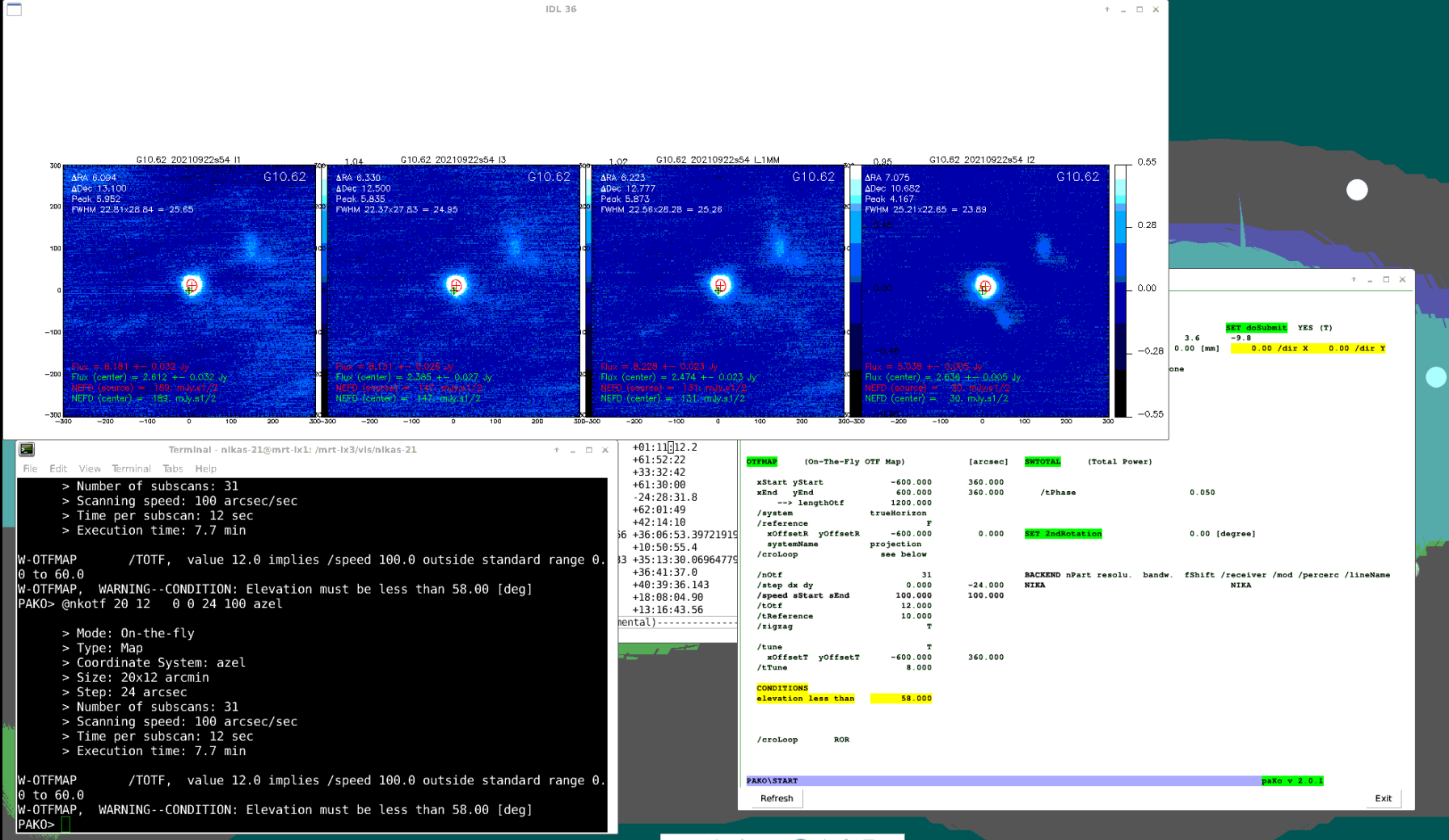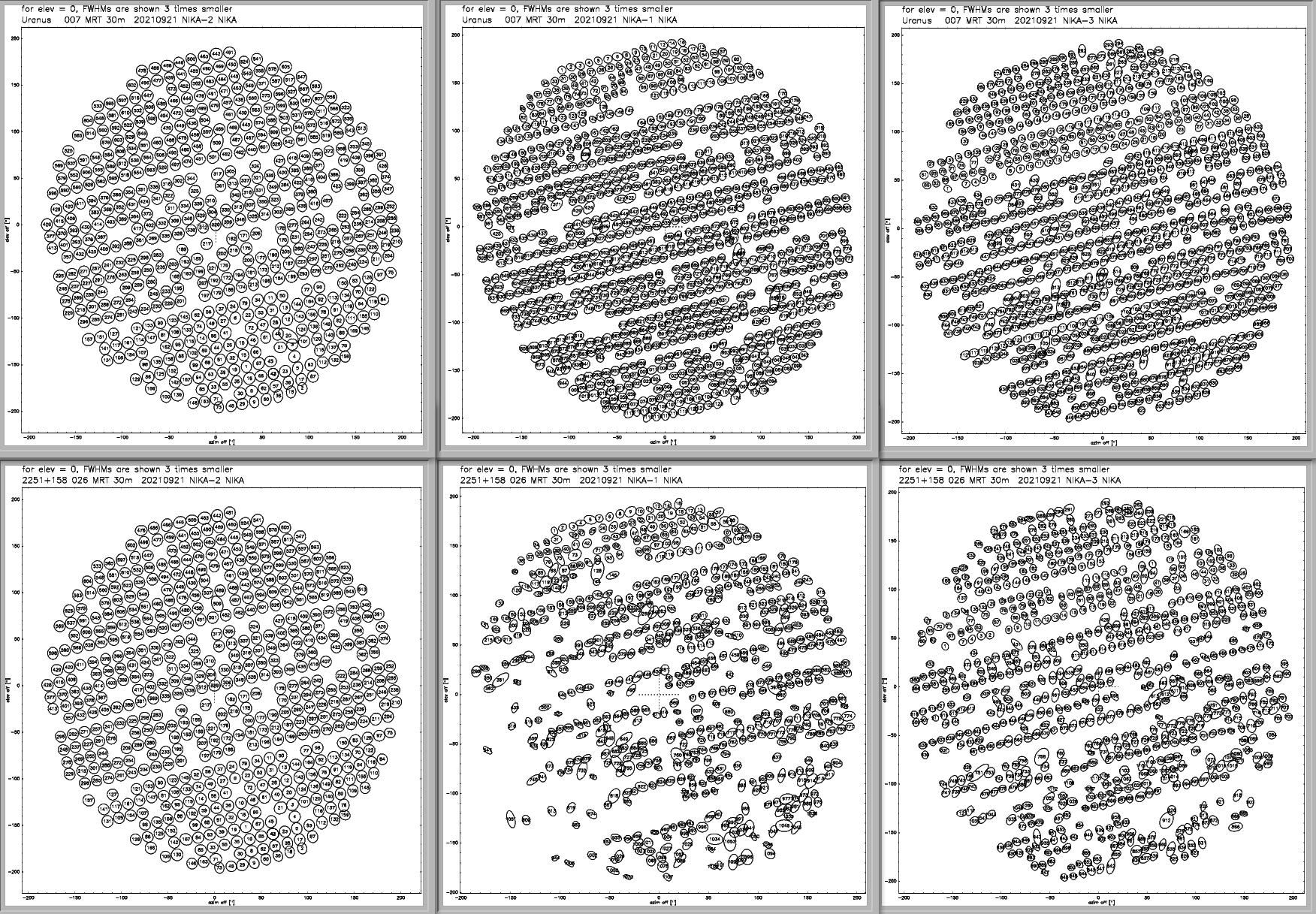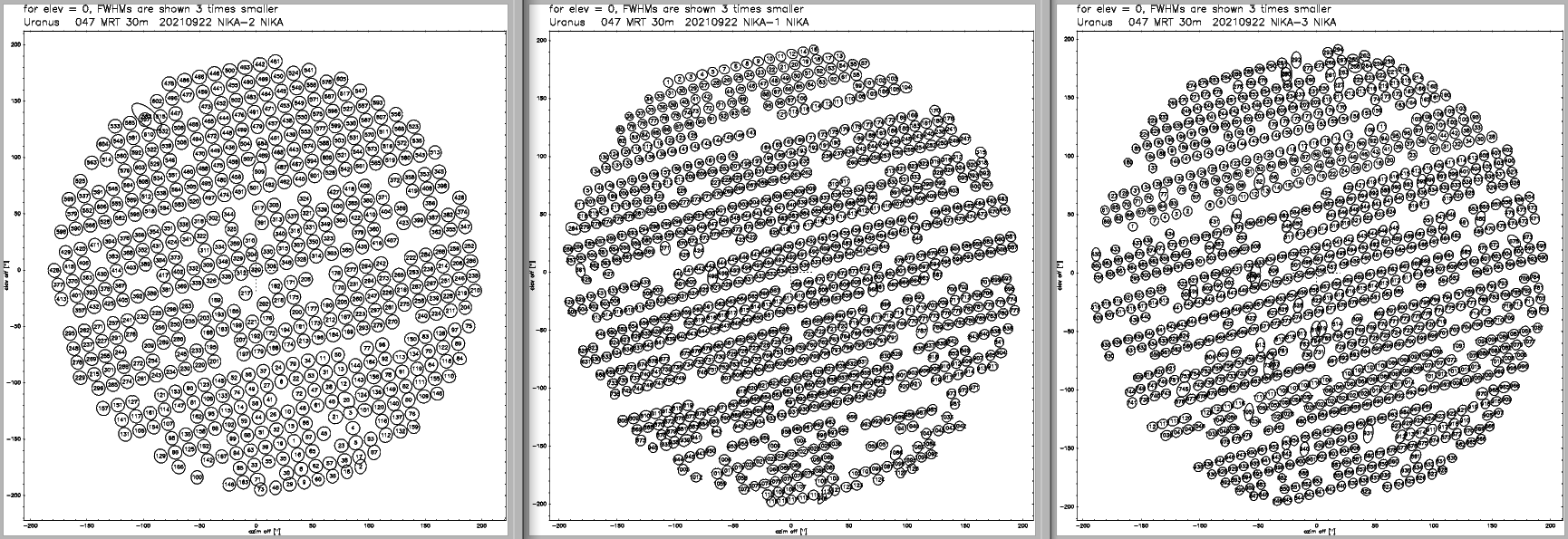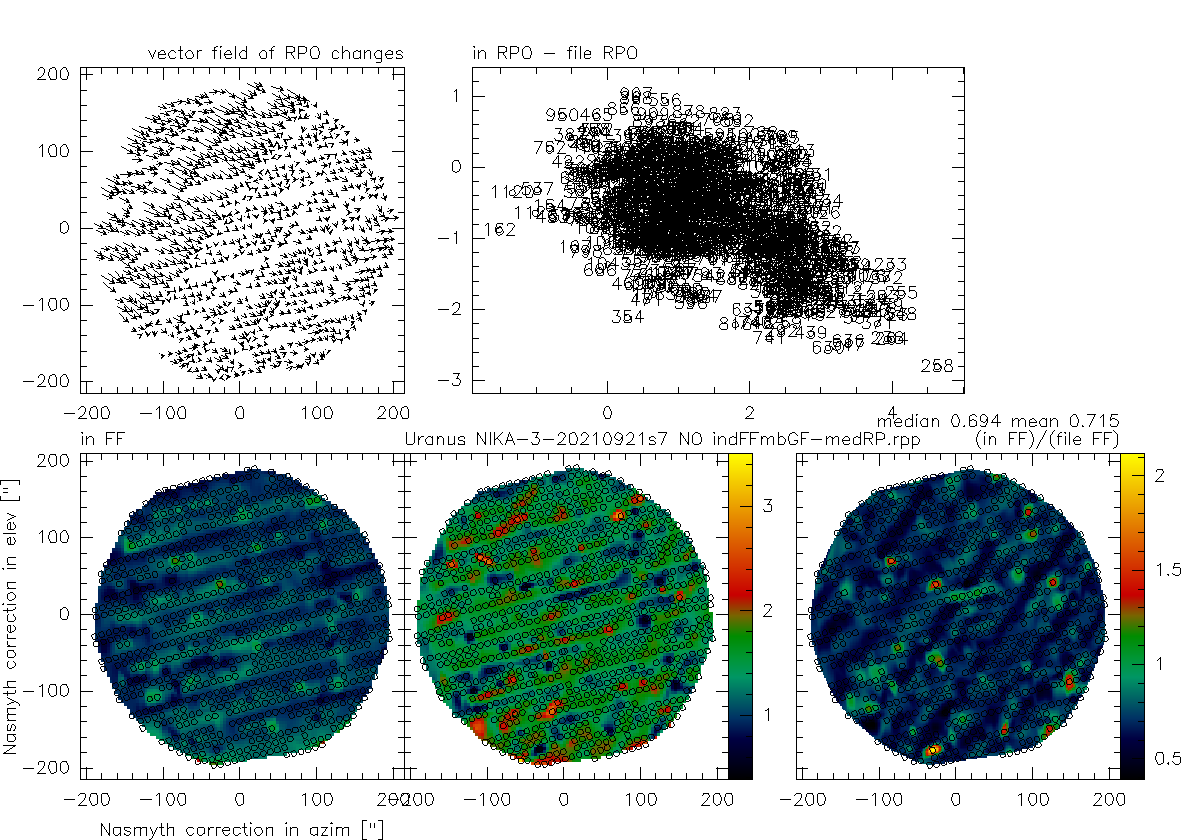Back to the NIKA2 Run 54 main page
Daily Reports
Contents
Remote observations.
Shifts after Sep. 20th to be defined (all times in UT):
SL: Given the bad weather forecast, it seem very likely that it will not be possible to take a beam map of good enough quality to create the new geometry of the arrays after the new sweep. Although the new frequency sweep doesn't require any particular weather condition since it's done with the cryostat window closed, it was decided to postpone it for now. The sweep will be done by Martino, with Angel on line with him in order to start learning the process.
So for the first nights the 2 goals are (1) doing tests with tha external calibrator source that is installed in the secondary mirror vertex, and (2) check the instrument observing setup and calibration with the same tones structure (array geometry obtained after a sweep) as the one used over the last year till now, mainly check pointings, focus, calibration on primary and secondary sources.
September 20th, Monday
Nico, Xavier, Martino, Ioannis:
SL: Tests done in polarization mode on the external calibrator source in M2. Mainly switch on and off each of the 2 channels of the calibrator : channel 1 that emits linearly polarized frequency lines at 232.5 and 263.5 GHz, and channel 2 that emits circularly polarized lines at 139.5 and 170.5 GHz, with some possible higher harmonics in the channel 1 bands. The goal is to characterize and understand the power received from each of the channels and the polarization state from each of them as a function of elevation. The main kind of scan allowing to do such test is the skydip script.
Seven scans were obtained and the data are exploitable. Skydips from 80 down to 10 by steps of 5 degrees (the telescope cannot go outside these bounds). 4 first scans without the HWP. Last 3 with the HWP rotating in front of NIKA2. Data reduction in progress (once nika2-b resumes normal performance).
Ioannis, Angel:
Starting at 23:40 (UT) with calibrations in total power using Uranus. Mean pointing offsets: 3, -7 arcsec. After focus (best value -0.15), the best beam sizes obtained are around 13 arcsecs in 1mm and 17.9 arcsecs in 2mm. After that, we tried a beam map on Uranus (20210921s7). Opacity was about 0.3 and the humidity level very high (99%). The weather conditions are not so good, probed by the peak-to-peak variations of the baselines (up to +/- 5 Jy). We proceed with a calib_1scan on Uranus (s8). Then we go to NGC7027 and do pointing and focus. Then calib_1scan to NGC7027, CRL2688, MWC349 (s16 to s18). Then we proceed to the quasar 2251+158 for pointing, focus (best value -0.1), again pointing with best beam size ~18 arcsecs at 2mm and then a beam map (s26). Latest polami observations in July measured ~5 Jy at 3mm and ~2 Jy at 1.3mm for this source. NIKA2 pointing gives ~4 Jy at 2mm. Weather radar shows that (electric) storms are approaching. After this beam map, we do a skydip (s27). Then we go to HLTau for pointing (~18 arcsecs at 2mm) and calib_1scan (s29). PIIC and IDL give very different pointing results. IDL has a very large value in azimuth, so we select the PIIC result. Try again to point on HLTau with nkpointf and IDL results are in better agreement with PIIC, but the fit is not very good, possibly due to deterioration of weather conditions (peak-to-peak variations of baselines are about +/- 10Jy). Then we go to 0529+075 for pointing (~18.3 arcsecs at 2mm) and to ALFORI for calib_1scan (s32). HLTau and ALFORI are faint but observed as a test to check if they "survive" in the calibrators catalog. Finally we stop at 05:30 (local time) due to weather conditions deteriorations.
NP: Thank you Ioannis and Angel for these observations and the summary. I checked the IDL results on HLTau pointing for a bug that would lead to abnormal azimuth correction. I see the misunderstanding. In the terminal, the output of IDL is the pako command for convenience "IF A2 PROFILES ARE NICE". Which is not the case for this scan. In such case, the user may refer to the above lines in the terminal "If A2 profiles cannot be used, then you may try values derived on the maps", that give "Array 2: set pointing 7.0 -6.7", in good agreement with the corrections derived by PIIC.
IM: Thank you Nico for the clarification. This makes the issue clearer and the pointing corrections are indeed in good agreement. We make a note to check the A2 profiles and proceed according to your guidelines.
September 21th, Tuesday
Angel:
Starting at ~21:30 (UT). Problems with nika2-a VNC desktops: fixed by Gabriel (AoD) & Dave. Pointing and focus on Uranus. As planned, we got additional pointing offsets on several sources: Neptune, 2251+158, G34.3. On average, offsets are about 2.8, -9.2 arcsec. Mean tau(225 GHz)~0.55 over this pointing monitoring. Resonances reworked looking to reduce the raw number of bad KIDs (A1, A2, A3): 91, 14, 51. These numbers were inadvertently higher at the beginning of the session. Coming back to Uranus and new, careful pointing/focus corrections were obtained. Large opacity spikes after that. Waiting for a while. Beam sizes about 17.5" and 11.9" after pointing. A calib_1scan tried on Uranus (20210922s3): noticeable opacity increasing. A new calib_1scan on Uranus under a bit more stable conditions (s5); beam sizes of 17.4" and 11.8". Moving to Neptune. A calib_1scan (s8) after a pointing correction. Looks unstable. Ioannis taking over at 1:20 (UT).
Ioannis:
Begin with Neptune. First pointing shows very unstable conditions with baseline variations at +/- 15-20 Jy. Opacity continues to increase and being unstable, tau225 shows 0.6-0.8 peak to peak and humidity is very high (100%). Pointing and focus on Neptune improves the beam sizes slightly with best values 17.8" at 2mm and 12.0" at 1mm. Then I tried a calib_1scan on Neptune (20210922s16). Then I go to NGC7027. Initial pointing shows low baseline variations at +/- 0.5 Jy but beam sizes look larger (14.2" at 1mm and 18.8" at 2mm). Taumeter plot shows large spikes and unstable tau225 values (0.6 - 0.8 peak to peak). A new focus shows much better results based on all focus criteria. After setting the best value (-0.9) the beam sizes are more or less unchanged (14.6" at 1mm and 18.7" at 2mm), so it is most likely due to weather deterioration or decreasing elevation (currently at 30 deg). Nevertheless, I try calib_1scan on NGC7027, CRL2688 and MWC349 before the sources go any lower (s24, s25 and s26). On average, pointing offsets are about 2.4, -5.4 arcsec up to now. Next I go back to Neptune for pointing (good beam sizes: 11.8" at 1mm and 17.8" at 2mm) and one more calib_1scan (s28). Since the beginning of my shift, tau225 shows large variations (0.5 - 0.9 peak to peak). After that, I go to the quasar 2251+158 (3C454.3). After pointing and focus (have been focusing every ~1hr due to unstable weather conditions), the best beam sizes are 11.5" at 1mm and 17.5" at 2mm. Then I try a beam map on 2251+158 (s36), followed by a skydip (s37). Then I did a calib_1scan on ALFORI (s39), after pointing on 0529+075 (18.2" at 2mm). Waiting a bit for Uranus to get below 60 deg elevation. After pointing and focus (best value -0.67) on Uranus, the best beam sizes are 13.3" at 1mm and 17.9" at 2mm. Then I try another beam map (s47) and calib_1scan (s48) on Uranus. Taumeter continues to show large spikes but tau225 is gradually getting lower (currently ~0.5). Then I do another skydip (s49). Finally, I go to HLTau for a last calib_1scan (s51) after pointing at the same target. I stop observations around 06:00 (UT), since no more calibrators are available at the moment and soon the EMIR heavy maintenance works will restart. Throughout my shift, the average pointing offsets are about 3.8" in azimuth and -6.7" in elevation.
September 22th, Wednesday
Xavier, Martino, Ioannis, Angel:
Starting at ~20h (UT). Tau(225 GHz) about 0.4. Test run on behalf of ARSENAL; nikas-21 account. Acquisition started with a frequency sampling of 48 Hz. First test of fast-moving procedure (20' x 12', 24"/step, 31 subscans + 1 tuning, 100 "/s, 12 seconds, 7.7 min.) on G10.62 (scan 53) after pointing on this source (offsets: 3.6, -9.8). Same procedure was applied twice (radec & azel) for mapping Abell 2163 (scans 54 and 55). Tests finished at 20h50m. Here is a screen of the quick look analysis on this galactic source G10.62:

Angel:
Acquisition restarted after configuring frequency to 24 Hz in run66.ini file (project t22, first scan after restarting: 57). Trying to start calibrations at 22h after the appearance opacity spikes of about 0.6. Best pointing offsets with Uranus: 4.2, -9.9. Pretty unstable most of the shift, with large excursions of peak-to-peak, uncorrected baselines: +/-3 to 5 Jy/b (2 mm) and +/- 20 to 30 Jy/b (1 mm). Waiting for an improvement that never happened, we tried 2 scans on M33 (20210922s76 and s78). Comment by CK: M33 is a very extended, weak science target, which doesn't seem to be an appropriate target for testing under meager conditions. Opacity increased suddenly at the end of the shift. Relative humidity >95%. Observation stopped for a while.
Ioannis:
Taking over from Angel at 01:15 (UT), but the atmospheric conditions are too unstable to start with observations. Tau(225 GHz) is close to 1 and the wind velocity around 15 m/s. I wait for conditions to improve. At 02:10 (UT) the telescope moves to stow position due to high wind velocity. At 02:30 (UT), the opacity seems stable and low, tau(225 GHz) around 0.3 at the moment. I go to the quasar 2251+158 for a test observation. Beam size has decreased but baseline variations are still high (+/- 20 Jy/Beam). Next pointing on Neptune shows smaller variations (about +/- 3 Jy/Beam), so I try to focus. Focus curves look decent but beam size very big, maybe due to low elevation (~ 25 degrees). Additionally tau(225 GHz) had a spike, reaching 0.8, and the wind velocity is rising again. Going to Uranus to check at high elevation (currently 68 degrees). After another focus (best value -0.4), the beam map sizes are still large 20.3" at 2mm and 19.0" at 1mm. Conditions are still unstable, probed by taumeter and baseline variations (latest about ± 20 Jy/Beam at 2mm). Waiting a bit for conditions to improve. Telescope stopped at 03:45 (UT) due to high wind velocity.
RZ: the beam maps

Beams of ar2 (left), ar1 (middle) and ar3 (right); top Uranus, bottom 2251+158 observed on Sep 21.

as above only for Uranus observed on Sep 22.
During both nights the beam shapes changed considerably across the FoV (effect of the z-focus variation of >0.7mm across the FoV), i.e. the telescope was deformed. With ~3Jy @1mm and the line-of-sight tau even >2 2251+158 is not strong enough to appear in maps of each individual KIDs with sufficient S/N


The figures compare the change of the relative calibration (bottom) and of the beam positions (top). All arrays show the same, therefore only ar3 shown. The anomalous refraction during the night of Sep 21 was quite high and distorted the FoV. The night of Sep 22 was much more stable. RPO = receiver pixel offset in the FoV, FF = flat field
September 23th, Thursday
Angel:
Tau(225 GHz) at ~0.45 at 19:30 (UT). Pointing and focus tried on 2251+158; opacity & rel. humidity increased a lot meanwhile. Extremely unstable, unlikely beam sizes. Observations stopped at 20:30. Opacity dropped firmly up to ~0.28. Resuming at 21:35. A decent focus (-0.65 mm) was found after a couple of tries. Beam sizes about 2-3" larger than expected and distorted; baseline fluctuations of about 12 Jy/b (2 mm) and 40 to 50 Jy/b (1 mm). Monitoring conditions through pointing scans every 20' to 30'. Expected beam sizes recovered after 23h, not so stable. A calib_1scan (s61) on Neptune. Mean opacity is about 0.35, but the instabilities tend to increase. Moving to Uranus at 23h35m. Baseline fluctuations of above 50 Jy/b (2 mm) and 100 Jy/b (1 mm). Extreme instabilities after 23h50m, followed by increasing opacity. First alarm due to wind gusts triggered at 00h35m. Stopped.
Ioannis:
Bad weather: strong opacity, high wind speed.
September 24th, Friday
Bad weather.
